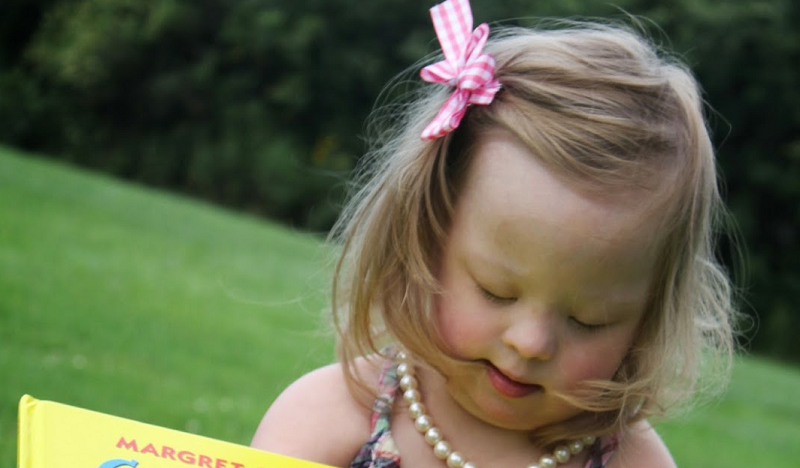In a beautiful article in The Huffington Post, Deanna Smith describes how her daughter, who has Down syndrome, can’t be defined by a “list” of abnormalities.
Smith writes, “When my daughter was diagnosed with Down syndrome, I was given a list. A list of potential features and problems to expect. This list is cold, emotionless and almost comes across as grotesque if you are reading it with fear already in your heart. The sharply angled words on this list tore apart my motherhood dream and became almost like a “side effects” commercial gone wrong. Now the list has become a part of my life, and I think that whoever created it didn’t capture the spirit of their assignment. It’s as if someone was told to describe Christmas and they said that it might include an evergreen tree and cold weather.”
If you are unfamiliar with Down syndrome, here’s a summary of some of the “problems” mentioned when parents first find out their child has the condition. Their child will most definitely have an intellectual disability, mental retardation, potential heart problems and some “strange” physical features. These features include: short fingers, small hands, flattened face, small nose and abnormally shaped ears, upward slanting eyes, and poor muscle tone. Sounds frightening and overwhelming right? However, instead of looking at this list in a negative light, Smith decided to embrace them.
This is how she described her daughter’s intellectual disability: “She knows the list says [she has an intellectual disability] this, and she uses this knowledge to pretend that she doesn’t understand instructions, while she does whatever she wants, grinning at pulling yet another fast one over on me. There is a difference between developmental delay and “stupid.” Addison is the farthest thing from stupid. In fact, I would venture to say that she is smarter than both of her Master degree-holding parents. Things take longer for her to learn, but she gets there. In her own time, she gets there and then she makes us all wonder why we were in such a hurry.”
In response to her daughter’s low muscle ton she says, “This means that when she wraps herself around me for a hug, her entire body melts into mine with a warm grasp that makes all other hugs suddenly seem lacking in comparison. When I pick her up in the morning, there is something wonderful about the way she melts into my arms, rag-doll fashion. Her arms reach up to hold onto my neck, and her face presses into me. Never do I feel needed and loved more than when she lets me carry and hold her.”
Click here to sign up for daily pro-life news alerts from LifeNews.com
Smith’s depiction of a child with Down syndrome stands in stark contrast to some individual’s reaction to children with the condition. In fact, as LifeNews previously reported, Rayna Rapp, a former abortion clinic worker who aborted a baby with Down syndrome herself, conducted a survey of women and couples who sought amniocentesis to screen for Down syndrome and other problems with their babies. All of the interviewees intended to abort if the baby was found to have Down syndrome. A few of the interviewees said the most horrific comments about children with Down’s; one said, “It’s devastating, it’s a waste, all the love that goes into kids like that.”
Another disturbing response was, “I think it’s kind of like triage, or like euthanasia. There aren’t enough resources in the world. We’d have to move, to focus our whole family on getting a handicapped kid a better deal… Why spend $50,000 to save one child?” And probably the worst, “Having a “tard,” that’s a bummer for life.”
Thankfully, Smith has a much better perspective because she sees the value and beauty of all human life. She also doesn’t criticize her daughter’s unique physical appearance like her flattened face. She says, “This describes the most delicately beautiful face that fills my entire world with joy. Those cheeks are the ones that curve upward into the most gleeful smile imaginable. The extra flatness across her eyes and nose, adds a sort of exotic beauty, an air of mystery, a unique kind of charm.” And to describe her daughter’s eyes she says, “[Her eyes are]…the almond-shaped windows into my daughter’s soul. The most beautiful soul housed in the most beautiful eyes. This unique shape only adds to the beauty that is Addison.”
What does this teach us? It teaches us that instead of defining a person by what they can or cannot do, or by how they look, they should be defined by who they are. It also teaches us that medical professionals should give parents a more accurate description of children with Down syndrome that shares ALL the facts.
This is what Smith recommends doctors do when they confront parents expecting a child with Down’s: “So I think when doctors hand over the list to new parents shocked with a new diagnosis, they should include all the facts. Like: This list really means nothing. Yes, you are about to have a baby. A super-cute, amazing baby. A baby who will rock your world in unexpected ways. A baby who will have struggles and strengths. A baby who will steal your heart and make you wonder how your life even existed before this baby came into your life. A baby who might have some extra health problems but who was paired perfectly with a fighting spirit to overcome and thrive.”
To read Smith’s complete description of her daughter click here.









